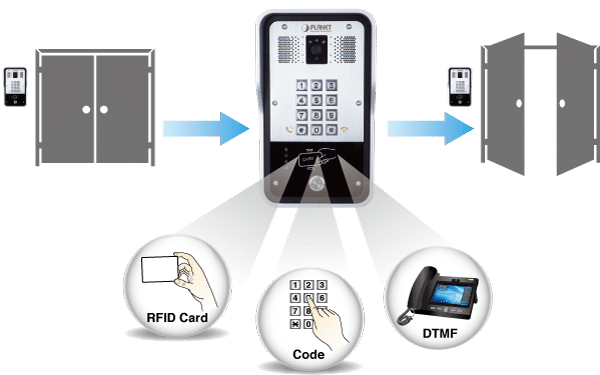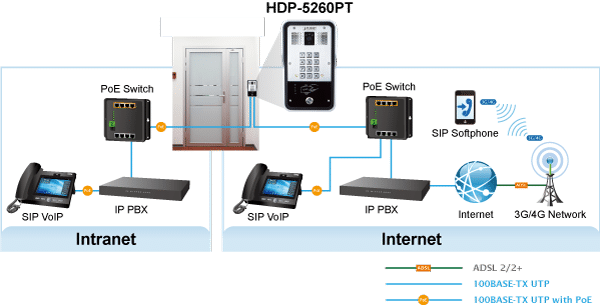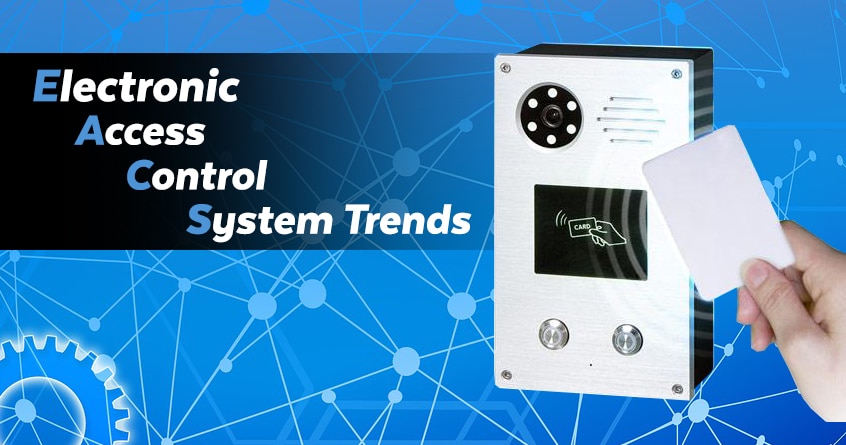The security of school campuses, businesses, hospitals, residential units, and other organizations is experiencing constantly changing, near-frenetic needs. Electronic access-control systems (EACS) installed onsite help to protect people, facilities, assets, and intellectual property from potential threats and theft. These units may be powered by a traditional electrical circuit or Power over Ethernet (PoE).
Let’s discuss EACS and explore five major trends.
What is an Electronic Access-Control System (EACS)?
Most people have had the experience of being buzzed into a controlled area or room. The buzzing sound that happens after face recognition by a receptionist or other personnel is due to the alternating current coming from the power source that causes the lock to vibrate. Electronic access control systems restrict entrance to a building, property, or room to authorized personnel only. An EACS uses electric locks, access control cards or a touchpad, and a reader in order to limit access to the doors an employee, student, or contractor may enter.
The process involves the swiping of a magnetic card through a cardholder, presenting a smart card or fob to a reader, entering a numeric code into a keypad, or scanning a fingerprint or handprint. Readers are installed outside doors and are the only visible part of the system. Credentials are then transferred to a data control unit or panel.
The controller validates the who, what, when, and where of the card, credential, or biometric entry based on data formatting, time, programmed reader location, and whether the cardholder or credentials owner has permission to access the location at that specific time. Once the controller processes the information, access is either granted or denied by data being sent back to the reader.
Finally, a transaction record is logged into the host system for future audits and review.

Five EACS Trends to Be Aware Of
Campuses and organizations must continually strategize to meet ever-shifting security needs. The rapid pace of change across the security industry has led to the emergence of the following trends.
Touchless Everything
Controlling the transmission of viruses and germs has long been paramount to employees and residents of healthcare facilities, hospitals, and independent or senior living environments. Thanks to the recent pandemic, this hygiene phenomenon has made its way into the rest of the population. The industry can expect to see touchless technology as a design standard, especially in public areas where transmission is always a concern.
Panic-style Door Hardware
Panic hardware, also known as an exit device, provides fast and easy egress to building occupants in the event of an emergency. These PoE-powered devices include the reader, a request-to-exit sensor, and a door position sensor as integral elements of the panic-style locking hardware.
Increased Use of Wireless Locks, Particularly in the Education Sector
Wireless locks are basically a standard in higher education. Dorm room residents’ school IDs are the credentials that get them into their dorm rooms. Anywhere a one-card credential solution is deployed, information is updated in the lock via the card. Cards are updated daily via a device installed at the entrances or common areas within the building.
Wi-Fi Locks and AI
Wi-Fi locks, not to be confused with wireless locks, leverage a building’s Wi-Fi network infrastructure. There is no need for a wireless hub connected to the hardwired or wireless infrastructure, which wireless locks report to for connecting to the ACS software or head end.
Artificial Intelligence (AI) makes automated or touchless access more convenient and cost-effective. It leverages existing or planned infrastructure without sacrificing physical security or cybersecurity.
Widespread Use of IoT
Convenience and the utilization of technology are becoming the norm. There is already widespread use of the Internet of Things (IoT) in homes, offices, and businesses. This trend is expected to continue as electronic access control systems become omnipresent.
An Overview of PoE Access-Control Systems
PoE-based access control systems integrate into a facility’s existing IP infrastructure. Single-door access control panels, which are powered either by a midspan PoE injector or a PoE switch, can be located above each door as edge controllers. The system can communicate with key points in the access control network, such as electric door locks, exit request devices, and biometric readers.
 The Benefits of PoE Access-Control
The Benefits of PoE Access-Control
Benefits of PoE access control include:
- Flexible installation – PoE cables transfer both power and data to each device attached to the local area network (LAN). It expands the flexibility of device positioning, allowing devices to be installed into a network with no concern for their proximity to AC outlets.
- Cost-saving – By leveraging the existing IT network, PoE eliminates the need for a local power source. This saves money in terms of wiring and outlet installation and maintenance.
- Easy and safe management – PoE uses a centralized power source. This allows remotely powered devices to connect and disconnect during service disruptions and reconfiguration easily. PoE access-control systems broaden security initiatives by supporting CCTV devices for better surveillance.
PoE access control saves time, and resources.
PoE Access-Control Limitations
While there are many advantages to PoE access control, there is one drawback.: limited power transmission to connected equipment. In addition to powering the controllers, PoE switches supply power to ancillary devices such as card readers and fail-secure electric strikes. Every component connected to a PoE controller must be prescreened to ensure the total amperage draw for all components is less than the total output limits of the controller.
Still, a PoE access-control system can meet most application needs despite this limitation.
VERSA Technology USA
Versa Technology, Inc. provides custom PoE solutions to support electronic access control systems. Finding ways to address security through technology, we offer top-notch service and customer support. Since 1994, it has been our mission to offer versatile products that are both cost-effective and user-friendly.
Contact us today for more information or help with your EACS needs.

